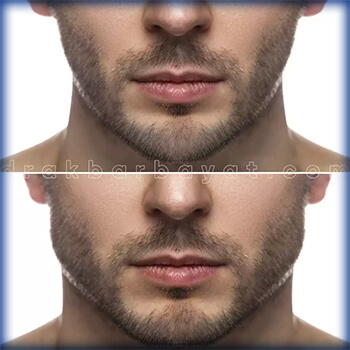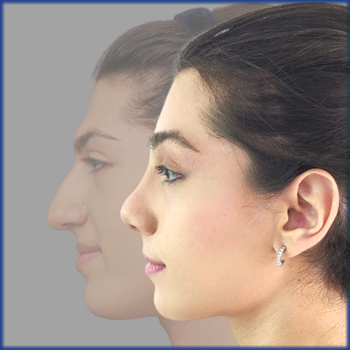
As seen in this figure, a child with polio who has not used much his left leg will have a small, thing left leg when he grows older. That is, not only his muscles are smaller due to lack of physical activity, but also the bones of the left leg are not well developed. This is also true of the nose. Proper development of sinuses, nasal cavities, cheeks, the upper jaw, teeth, and in general the middle part of the face depends on sufficient breathing through the nose during childhood and adolescence. Insufficient breathing will result in disordered shape of the nose and the face as explained further in the following sections.
-
Total nasal congestion
Total nasal congestion during childhood for any reason that prevents normal breathing through the nose (e.g. a large third tonsil) will result in underdeveloped nose which looks relatively smaller and thinner than normal noses. Children with this complication will have a disproportionately wide face with bossed cheeks in adulthood. Given the relative thinness of the upper part of the nose in these people, the tip of the nose may appear unusually large (Figure 1, right). These people are often characterized by leaving their mouth open and showing their teeth even when they are not smiling or talking (Figure 1).
Figure 1: Disproportional development of some parts of the nose as a result of total nasal congestion during childhood
Partial nasal congestion
The nose consists of several muscles that help expansion of nostrils. These muscles are used when one needs to inhale a larger amount of air (for example, during exercise). Partial nasal congestion during childhood will lead to more frequent activation of these muscles and this, over time, will give the lower part of the nose a wider look with larger nostrils (Figure 2).
Nasal Fracture
Although nasal fracture during childhood may seem unimportant and negligible, such fractures, over time, may lead to deviated nasal bones and an undesirable or asymmetrical look (Figure 3).
Constant congestion in a nasal cavity
A constant congestion of a nasal cavity during childhood may lead to uneven growth of nasal cavity and sinuses at either side, which eventually results in one side looking smaller or larger than the other. Although almost all healthy people have a certain degree of unevenness in their faces, but the problem is more apparent in those who experienced congested cavity at one side (Figure 4).
Nasal polyps
Nasal polyps develop when the mucous inside the nose grows abnormally due to allergy. Untreated polyps may fill in all nasal cavities, resulting in a wider look of the nose because of extruded bones which exert pressure over the cavity walls. This is not limited to children and may appear in adults as well (Figure 5).
Diseases and disorders that may affect the shape of the nose
The factors listed above just reflect a number of environmental factors affecting the shape of the nose. Scientifically speaking, in sum, all chronic sinus and nasal diseases during childhood may affect what nose will look like in adulthood. Therefore, proper treatment of these disorders can prevent further problems in future.
In case of observing any of the following problem in your child, it is recommended to visit an ENT doctor for treatment.
- Children who always sleep with their mouth open
If your child has this problem only when he or she catches cold and he or she breathes normally on other days, there is no need for further examination. However, a checkup is recommended if your child catches cold more than five times a year. - 2. Constant nasal discharge or pus in one or both nasal cavities
- A newborn or an infant with nasal congestion needs to stop suckling at times to breathe. Therefore, potential nasal congestion should be examined in infants that cannot breastfeed normally.
- Children that suffer from nose injuries should undergo examinations for nasal fracture. It should be noted that fractures should be treated within 5 days since fracture healing occurs quickly in children.
- Children with recurrent tonsil disorders
For more information on tonsil disorders see here. For instructional movies on tonsil disorders see here. - Children with recurrent sinus disorders or nasal polyps


